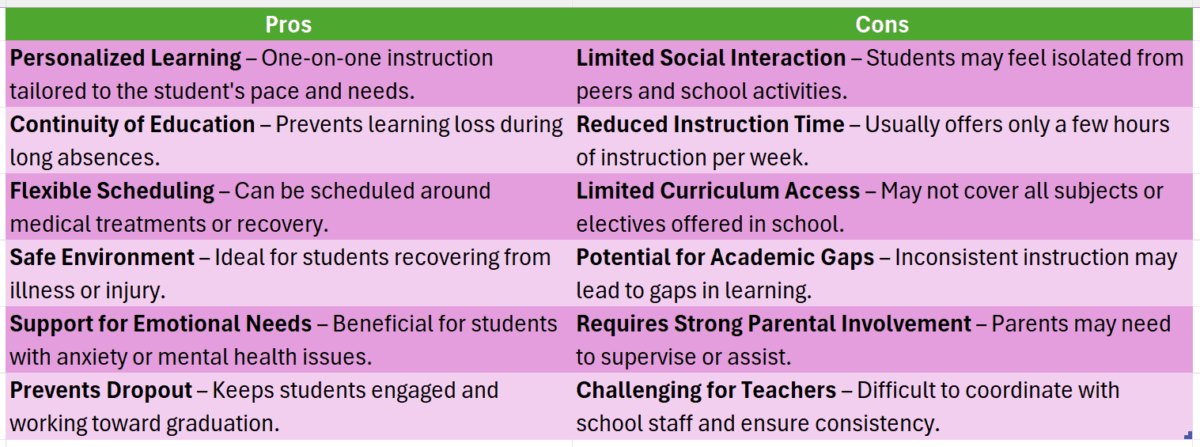Homebound instruction is a vital educational service designed for students who cannot attend school due to medical or emotional challenges. Understanding this concept is crucial, as it ensures that these students continue their learning journey, even from home. This support not only helps them academically but also fosters a sense of belonging and connection to their peers and teachers.
What Is Homebound Instruction?
Homebound instruction provides tailored educational experiences for students unable to participate in traditional classroom settings. It often includes:
- One-on-one teaching sessions
- Customized lesson plans
- Flexible scheduling to accommodate health needs
This approach allows students to receive specially designed instruction examples that meet their unique learning requirements.
Who Does Homebound Instruction Serve?
This service is beneficial for various students, including those with chronic illnesses, mental health issues, or disabilities. Additionally, community-based instruction plays a significant role in helping these students engage with their surroundings. By focusing on real-world applications, students can learn essential life skills while remaining connected to their community.
Study smarter, not harder—Enroll online today!
The Importance of Homebound Instruction for Student Success

Homebound instruction is a vital resource for students who can’t attend school due to health issues or other challenges. It ensures that learning continues, allowing these students to stay on track with their peers. By providing tailored support, we can help them thrive academically and socially.
Key Benefits of Homebound Instruction
- Personalized Learning: Homebound instruction offers specially designed instruction examples that cater to each student’s unique needs.
- Flexibility: Students can learn at their own pace, making it easier to grasp difficult concepts.
- Community-Based Instruction: This approach helps students connect with their local community, enhancing their learning experience and social skills.
By implementing homebound instruction, we create a supportive environment where students can succeed. It’s not just about academics; it’s about fostering confidence and independence. With the right resources, every student can shine, no matter where they are learning from.
How to Identify Students in Need of Homebound Instruction
Identifying students who need homebound instruction is crucial for their academic success. These students may face health issues, emotional challenges, or other circumstances that prevent them from attending school. Understanding how to recognize these needs can help educators provide effective support and ensure that learning continues outside the classroom.
Signs a Student May Need Homebound Instruction
- Frequent Absences: If a student misses school often, it may indicate underlying issues.
- Health Concerns: Chronic illnesses or mental health challenges can hinder attendance.
- Academic Struggles: Falling behind in classwork can signal the need for specially designed instruction examples tailored to their situation.
Benefits of Community-Based Instruction
Homebound instruction can be enhanced through community-based instruction. This approach allows students to engage with their surroundings while learning. For instance, a student might explore local history through virtual field trips or participate in community service projects. This not only supports their education but also fosters social connections, making learning more relatable and enjoyable.
Creating Effective Homebound Instruction Plans: Key Considerations
Homebound instruction is crucial for students who can’t attend school due to health issues or other challenges. It ensures that these students continue their education and stay connected with their peers. Creating effective homebound instruction plans is essential for their success and well-being.
Understand Individual Needs
Every student is unique. Tailoring homebound instruction to fit their specific needs is vital. Consider their learning style, interests, and any special requirements. This is where specially designed instruction examples come into play, helping educators craft personalized lessons that resonate with each student.
Incorporate Community-Based Instruction
Engaging students with community-based instruction can enhance their learning experience. This approach connects lessons to real-world situations, making education relevant and exciting. For instance, a math lesson could involve budgeting for a community project, helping students see the practical application of their studies.
Engaging Students in Homebound Instruction: Strategies for Success
Homebound instruction is crucial for students who can’t attend school due to health issues or other challenges. It ensures they continue learning and feel connected to their peers. By implementing effective strategies, educators can create a supportive environment that fosters growth and engagement, making a significant difference in these students’ lives.
To make homebound instruction effective, consider these strategies:
- Personalized Learning Plans: Tailor lessons to meet individual needs, incorporating specially designed instruction examples that resonate with each student.
- Community-Based Instruction: Involve local resources, such as libraries or community centers, to provide additional support and learning opportunities.
Building Connections
- Regular Check-Ins: Schedule consistent communication to maintain a connection and assess progress.
- Interactive Activities: Use technology to create engaging lessons, like virtual field trips or online discussions, helping students feel part of the classroom community.
By focusing on these strategies, educators can enhance the homebound instruction experience, ensuring students thrive even outside traditional school settings.
Technology in Homebound Instruction: Tools and Resources
Homebound instruction is crucial for students unable to attend school due to health issues or other reasons. It helps them continue their education and maintain connections with peers. By utilizing the right tools and resources, educators can create a nurturing environment that promotes learning from home.
Engaging Tools for Learning
Technology plays a significant role in homebound instruction. Effective tools include:
- Video Conferencing: Platforms like Zoom or Google Meet enable real-time interaction.
- Learning Management Systems: Tools such as Google Classroom organize lessons and assignments efficiently.
- Interactive Apps: Educational apps offer engaging content tailored to individual needs.
Community-Based Instruction
Community-based instruction connects students with their environment, helping them acquire practical skills. For instance, virtual field trips can provide enriching experiences. Homebound instruction also incorporates specially designed instruction examples that cater to diverse learning styles, ensuring personalized support and engagement for every student.
Collaboration with Families: Supporting Homebound Students Together
Homebound instruction is vital for students unable to attend school due to health issues or other challenges. It allows them to continue learning and maintain connections with peers. Collaboration between families and educators is key to creating a supportive environment that promotes growth from home.
Open Communication
Open communication is essential. Regular check-ins with families enable educators to understand students’ needs and adjust homebound instruction accordingly, leading to tailored learning experiences.
Community-Based Instruction
Incorporating community-based instruction enhances learning. Local libraries and community centers can offer resources and spaces for education. Families can engage in activities that relate lessons to real-world experiences, making learning more enjoyable.
Specially Designed Instruction Examples
Families can aid homebound students by using specially designed instruction examples at home, such as hands-on projects, interactive online resources, or educational games. Together, families and educators can ensure students thrive, regardless of their circumstances.
Study smarter, not harder—Enroll online today!
Assessing Progress in Homebound Instruction: Measuring Success
Homebound instruction is essential for students unable to attend school due to health or other challenges. Assessing progress in this setting is crucial for providing the necessary support. By measuring success, educators can customize their teaching methods and keep students engaged in learning.
Setting Clear Goals
Setting clear and achievable goals is vital for measuring progress. These can include academic milestones or personal development targets, such as completing a specific number of assignments weekly or improving reading skills.
Using Community-Based Instruction
Incorporating community-based instruction enhances learning by allowing students to apply skills in real-world contexts. Regular check-ins help track engagement and understanding, ensuring students remain on track.
Specially Designed Instruction Examples
Utilizing specially designed instruction examples aids in assessing progress. Tailoring lessons to individual needs ensures students not only learn but thrive. Regularly reviewing these strategies allows educators to adjust their methods to support each student’s unique journey.
Challenges of Homebound Instruction: Overcoming Barriers to Learning
Homebound instruction is crucial for students who can’t attend school due to health issues or other challenges. Understanding the barriers they face helps us create effective strategies to support their learning journey. Let’s explore the challenges of homebound instruction and how we can overcome them together.
Understanding the Challenges
Homebound instruction often presents unique challenges. Students may feel isolated, struggle with motivation, or lack access to resources. Additionally, parents may find it difficult to provide the necessary support. Recognizing these hurdles is the first step toward finding solutions.
Overcoming Barriers to Learning
To effectively support students, consider these strategies:
- Community-based instruction: Engage local resources and organizations to provide additional support.
- Specially designed instruction examples: Tailor lessons to meet individual needs, ensuring they are engaging and relevant.
- Regular check-ins: Maintain communication with students and parents to monitor progress and address concerns. By implementing these strategies, we can help students thrive, even from home.
How Scholarship.Education Can Enhance Homebound Instruction Support
Homebound instruction is essential for students who can’t attend school due to health issues or other challenges. It ensures that these students continue their education and feel connected to their peers. But how can we enhance this support? That’s where Scholarship.Education comes in, offering tailored solutions to meet diverse needs.
Personalized Learning Plans
At Scholarship.Education, we believe in community-based instruction. This means creating personalized learning plans that cater to each student’s unique situation. For example, specially designed instruction examples might include interactive online lessons or one-on-one tutoring sessions. This approach helps students stay engaged and motivated, even from home.
Resources and Tools
We provide a variety of resources and tools to support homebound instruction. These include:
- Online platforms for virtual classes
- Interactive activities to keep learning fun
- Regular check-ins to monitor progress and adjust plans as needed
By utilizing these resources, students can thrive academically and socially, ensuring they don’t miss out on valuable learning experiences.
Study smarter, not harder—Enroll online today!
FAQs
1. What is homebound instruction?
Homebound instruction is temporary educational support provided at home for students who can’t attend school due to medical, emotional, or physical conditions.
2. Who qualifies for homebound instruction?
Students must have a documented medical or psychological condition, certified by a licensed physician or healthcare provider, that prevents regular school attendance.
3. How is homebound instruction requested?
A parent or guardian must submit a request to the school district, often including a physician’s statement explaining the student’s need for homebound services.
4. How many hours of instruction are provided?
Instruction time varies by state or district, but it typically ranges from 3 to 10 hours per week, depending on the student’s grade level and needs.
5. Is homebound instruction the same as homeschooling?
No. Homebound instruction is a temporary, school-provided service for eligible students, while homeschooling is a parent-directed, long-term educational choice.
6. Who teaches during homebound instruction?
Certified teachers employed or contracted by the school district provide instruction, either in person at home or virtually.





